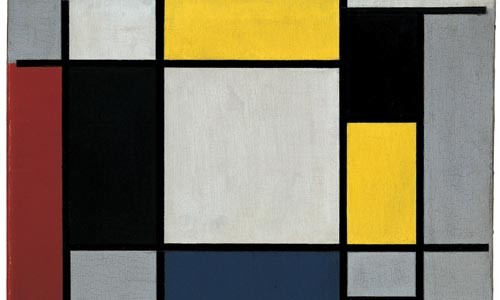In the April 7, 1945, issue of The Nation, critic Clement Greenberg wrote that Piet Mondrian's clean, rectilinear canvases bore a "naïve faith in the future." The paintings in question -- which were completed some years earlier, between the wars -- had overtly rejected the traditional aesthetics and social conventions that predated World War I. Greenberg's gentle criticism (couched in distinct admiration) might have been expected, given that he wrote the review around the time American troops liberated their first Nazi concentration camp, in Ohrdruf, Germany.
Now, nearly a century -- and countless military conflicts -- since these paintings' creation, what significance does Mondrian's naïve optimism hold? Beyond eliciting from viewers the usual aesthetic appreciation expected in response to a modern master, what broader significance do these paintings have in post-Abu Ghraib America? Actually, a great deal, since they are products of a mind that sought to reveal the emergence of a new world order through clean lines and primary colors.
The Warhol Museum currently features an extensive series of Mondrian's iconic works with Piet (Mondrian) in Pittsburgh. However, unlike such fascinating retrospectives as 2001's Without Sanctuary, in which the Warhol dealt head-on with such relevant (and sometimes difficult) phenomena as lynching, this exhibition largely denies historical and theoretical considerations to focus on the artist's abridged stylistic development between 1907 and 1937.
True, the chronological arrangement of 24 oil-on-canvas paintings boasts several pieces never before seen in America. Visitors move from salon-style works that shimmer with varnish, like "Farmstead on the Gein" (1907); past "The Mill" (1907-08), which resonates with Van Gogh-style brushwork; through Fauvist-inclined landscapes like 1909's Bonnard-worthy "Dune IV" and Cubist-influenced paintings like "Landscape" (1912); and to embryonic and then fully developed Neo-Plastic rectilinear distillations, like 1920's "Composition with Yellow, Red, Black, Blue and Gray."
Yet, as it stands, the show bears little explanatory information beyond titles and dates. And only briefly referenced, but never fully explained, is Neo-Plasticism, the movement Mondrian was involved in by 1920. The exhibition's final few works evidence the artist's attempt to purge the excesses of pre-World War I aesthetics, and substitute the 1920s Neo-Plastic ideals of utopian harmony and pragmatic order. And today, at a time when America faces its own political watershed (and perhaps even some grappling with its own "naïve faith in the future"), visitor awareness of this historical background would bring valuable eloquence to Mondrian's rigidly silent geometry.
Historical omissions aside, why bring Mondrian onto Warhol's turf when their styles and philosophies seem so divergent? The show's wall texts note that the exhibition is part of a cultural exchange between the Warhol and the Stedelijk Museum that began after a retrospective of Warhol's films opened in the Netherlands to critical acclaim. Yet here again, the Warhol misses an opportunity, failing to explore another implicit connection between the two artists, one that has more to do with how Mondrian's fully evolved Neo-Plastic imagery has become part of the pop-culture reservoir: Like Warhol's works, Mondrian's non-objective, geometric experiments are a widely recognized visual idiom, as familiar as Coca-Cola and Campbell's Soup. The proverbial Mondrian geometry appears on wallpaper, clothing, even cars.
Yet it's the lack of historical context that really robs the exhibition of its potential punch. Although Mondrian's works alone are remarkable examples of Modernism and its various permutations, their significance goes beyond their quiet iconic status. Understanding the utopian ideals they were intended to exemplify would fully reveal the politics and aesthetics from which they emanated. And in turn, the paintings (and their historical context) could potentially initiate debate about the direction politics, aesthetics -- even humanity -- are headed now. This would make them more than aging, wall-bound icons. It would make them intellectual catalysts, which is what Mondrian intended them to be in the first place.
Piet (Mondrian) in Pittsburgh continues through Aug. 31. The Andy Warhol Museum, 117 Sandusky St., North Side. 412-237-8300 or www.warhol.org















